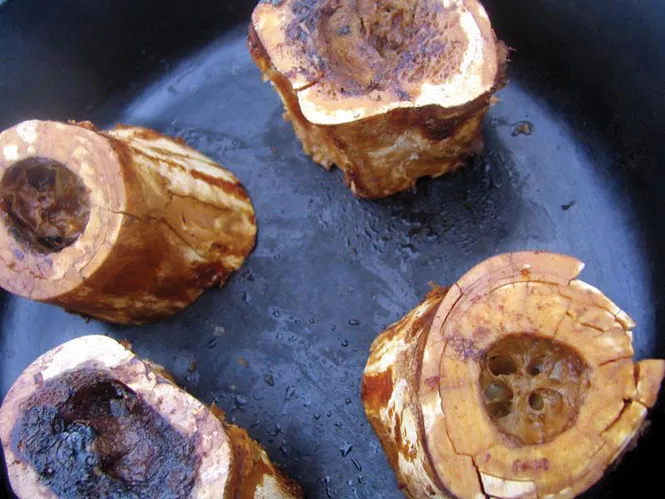For longer than there have been kitchens, people have found ways to boil bones. From rural villages to urban restaurants to Grandma's house, the virtues of bone stock—and its salted cousin, broth—are hardly a secret.
But lately, bone broth has boomed into a trendy end in itself. You can pay nearly $10 for ginger grass-fed beef broth at Brodo in New York City. You can drink it at the Jola Cafe in Portland, Ore. It's available online, shipped fresh to your doorstep.
If you've ever been lifted from the depths of exhaustion, hunger, illness or chills by a sip of warm broth, you might be inclined to believe in such restorative powers. Indeed, bone broth is a wonderful thing. Nonetheless, there are some potential downsides to broth, as well as some misconceptions, that are worth keeping in mind.
If bones from the wrong animal are used, broth can be a source of lead exposure. Lead can accumulate in plants and animals that are exposed to it via food, water or a contaminated environment. As a self-defense mechanism, exposed animals store lead in their bones, where it does less harm. Broth made from such bones can be high in lead. One prominent 2013 study made waves in the broth community by demonstrating higher lead content in organic chicken bone broth than from the tap water used to make it. This raised fears that bone broth should be avoided.
Sally Fallon and Kaayla Daniel, authors of the book Nourishing Broth, addressed this study in an extensive blog post for the Weston A. Price Foundation. They have issues with many aspects of how the study was conducted, including suspicions that the chickens used were exceptionally contaminated. Still, they acknowledge, bones should be chosen with care, because contaminated bones do exist.
Using organic bones wouldn't help one avoid this problem, as evidenced by the fact that organic bones were used in the study. In fact, organic products could contain more heavy metals than conventionallygrown food, because of the use of manure in many organic agriculture practices. Manure can be a concentrated source of heavy-metal contamination, and if it's used to grow animal feed, that lead will end up in the animals that eat it.
Amazingly, while lead will leave the bones for the broth, calcium does not, Fallon and Daniel write. According to Daniel, they've examined data from numerous batches of tested broth, and "every batch tested has shown low levels [of calcium], so it stays in the bone, most likely."
I don't know what to make of this, personally, having made and eaten stock in which the bones had become so soft I could eat them like soggy crackers. Given how long stock bones spend dissolving in hot water, it makes no sense to me that particles of calcium-rich material wouldn't be consumed along with broth. But, assuming it's true, Daniel pointed out a simple fix: Add veggies, which do contribute calcium.
However, calcium is hardly the only reason to consume bone broth, she wrote. "Bone broth builds bones, and the likely reason is, it's high in gelatin—collagen. And collagen is what provides the framework for good bones. That's what's needed to lay on calcium and other minerals. It's like rebar and concrete."
There are many variations on bone broth, with a diversity of finished outcomes attached to each. Vietnamese pho, made from cow bones, is very different from Japanese tonkatsu ramen broth made from pork bones, or veal-bone-based demi-glace in a fancy French restaurant, or Mom-style chicken-bone soup. Thus, I'll leave you with, not a recipe, but "BoneMan the Brotharian's Bone Broth Basics":
At its essence, making bone broth entails little more than cooking bones in hot water for 12 to 36 hours. A slow cooker is great for many reasons. Using one isn't as dangerous as leaving a stove burner on for days at a time, and the broth cooks slowly enough that you don't need to keep adding water. It's very convenient to have a crock pot going at all times with broth that's at the perfect sipping temperature, and available to be used in whatever's cooking.
The bones should be cut, which releases the marrow and other inner bone materials, and allows more surface area to contact the broth. When I make stock with the bones of a store-roasted chicken (lead alert!), I use a scissors to snip the soft bones to bits. With mammalian long bones, ideally the butcher will cut them; otherwise, cut them at home or whack them with a hammer.
If whacking the bones, make sure that the resulting bone splinters don't enter anyone's mouth, unless cooked to absolute softness. Some people simmer their bones in a fine mesh bag to keep them out of the broth, or pour the finished broth through a sieve. In my case, the broth just sits in warm mode in the crock pot. The bones settle, and as long as I use a ladle to serve it, there's no danger of bone fragments.
For best flavor, begin by roasting the bones in the broiler, turning them as necessary, aiming to brown but not burn. Add the bones to the stock pot, making sure to deglaze and scrape roasted bone drippings into the pot as well. Cook on the lowest setting you've got.
After about 12 hours, consider adding carrots, onions and celery. Don't get too fancy with your veggies; broccoli and cabbage will backfire if cooked too long, so use these and other calcium-rich veggies to make soup with after the broth is done.
Leave the broth unsalted in the pot until it's time to use it. Then season appropriately. If sipping, I like a splash of soy and a sprinkle of garlic powder.
Ari LeVaux writes the syndicated weekly food column Flash in the Pan.
More by Ari LeVaux
-
Savor the Season
Recipes to make the most of the fall harvest.
- Sep 22, 2021
- More »




